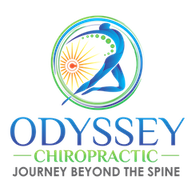How Upper Cervical Misalignment Affects Jaw Function and TMJ Disorders — A NUCCA Perspective
Temporomandibular joint dysfunction (commonly called TMJ) is a condition that affects millions of people, often causing jaw pain, clicking, headaches, facial tension, and difficulty chewing or speaking. While dentists and physical therapists often address local symptoms, many patients are unaware that jaw dysfunction can be linked to misalignments at the top of the neck—specifically the atlas vertebra (C1).
At Odyssey Chiropractic in San Francisco, we use a precise and specific, non-invasive technique called NUCCA (National Upper Cervical Chiropractic Association) to correct misalignments in the upper cervical spine. This gentle method often helps improve jaw function, reduce tension, and restore balance to the body by targeting a deeper root cause: neuromechanical imbalance between the skull, spine, and jaw.
What Is TMJ Dysfunction?
The temporomandibular joint (TMJ) connects your jawbone to your skull, acting as a hinge that allows speaking, chewing, and facial expression. TMJ dysfunction isn’t just a single condition—it’s a category of disorders involving:
- Jaw clicking or popping
- Facial and ear pain
- Headaches and migraines
- Restricted jaw movement
- Muscle tenderness around the face and neck
- Tinnitus or a sensation of fullness in the ears
TMJ disorders can be caused or worsened by trauma, teeth grinding (bruxism), stress, arthritis, or poor posture. But a less recognized factor is structural imbalance at the top of the spine—which can directly affect the way the jaw moves and functions.
The Anatomy: How the Atlas Affects the Jaw
The atlas (C1 vertebra) sits directly underneath the skull and supports the entire weight of the head. It also forms part of the craniocervical junction, where neurological and structural control of head posture, facial muscles, and jaw mechanics begin.
When the atlas is misaligned, even slightly, it can cause:
- Uneven tension in the muscles of mastication (jaw-closing muscles like the masseter, temporalis, and pterygoids)
- Asymmetrical loading on the TMJ joints, causing wear or inflammation
- Nerve interference or altered proprioception from the trigeminal nerve, which controls jaw sensation and movement
Because the jaw and neck are mechanically and neurologically connected, any shift in head posture or cervical balance can place the jaw in a compensatory, stressed position.
The NUCCA Approach: Precision Without Force
Unlike traditional chiropractic adjustments that may involve high-velocity thrusts or multiple areas of the spine, NUCCA is a gentle and highly targeted approach focused solely on correcting misalignments of the atlas vertebra.
At Odyssey Chiropractic, our NUCCA protocol involves:
1. Advanced imaging (Digital X-rays) to assess misalignment in three dimensions
2. Mathematical analysis to measure the exact correction angle needed
3. A gentle correction, usually done with light hand pressure and no twisting, cracking, or popping
4. Post-correction re-measurement and balance tests
By restoring proper head-on-neck alignment, NUCCA allows the muscles, joints, and nervous system to rebalance, which can significantly reduce TMJ-related symptoms.
Evidence Supporting Upper Cervical Care for TMJ
While more large-scale research is needed, several case reports and small studies support the use of upper cervical chiropractic care for TMJ disorders:
- A 2013 study in the Journal of Upper Cervical Chiropractic Research documented improved jaw range of motion and reduced pain in TMJ patients after atlas corrections.
- Clinical observations by NUCCA practitioners show that restoring craniocervical balance can help reduce tension in the jaw and face, often without direct manipulation of the jaw joint itself.
- Other studies have shown that head posture and cervical spine alignment significantly influence bite mechanics, occlusion, and temporomandibular joint loading.
NUCCA vs. Traditional TMJ Treatments
NUCCA doesn’t replace dental care or PT—it complements them. By restoring balance at the foundation of the skull and jaw, patients often report a decrease in jaw clicking, tension, and pain, even when other treatments had plateaued.
Treatment | Focus | Limitations
Dental splints or night guards: Preventing grinding, reducing jaw strain, may not address root alignment issues
Physical therapy: Rehabilitating jaw muscles, often addresses effects, not causes
Botox injections: Reducing muscular tension, provide temporary relief; doesn't improve posture
NUCCA Upper Cervical Care: Realigning the upper neck to restore balance, addresses structural root cause of tension
What to Expect at Odyssey Chiropractic
If you’re dealing with TMJ symptoms, your visit to Odyssey Chiropractic in San Francisco will include:
- A thorough health history and TMJ symptom screening
- NUCCA-specific imaging and analysis of your atlas alignment
- A tailored care plan that addresses your individual spinal misalignment
- Re-evaluation and progress checks to measure changes in posture and function
Our care is non-invasive, gentle, and neurologically focused, which means we aim to correct the deeper patterns behind TMJ dysfunction—not just mask the pain.
Final Thoughts: A Whole-Body Approach to Jaw Health
Jaw pain, clicking, and tension can be frustrating—and in many cases, the jaw isn’t the only area that needs attention. By correcting misalignment at the top of the spine, NUCCA care may relieve stress on the jaw joints and restore proper communication between the brain, nerves, and muscles that control jaw function.
If you live in San Francisco and are searching for a gentle, effective, and neurologically grounded approach to TMJ, we invite you to schedule a consultation at Odyssey Chiropractic. You may discover that the key to relieving your jaw pain lies not in your jaw—but in your neck.
